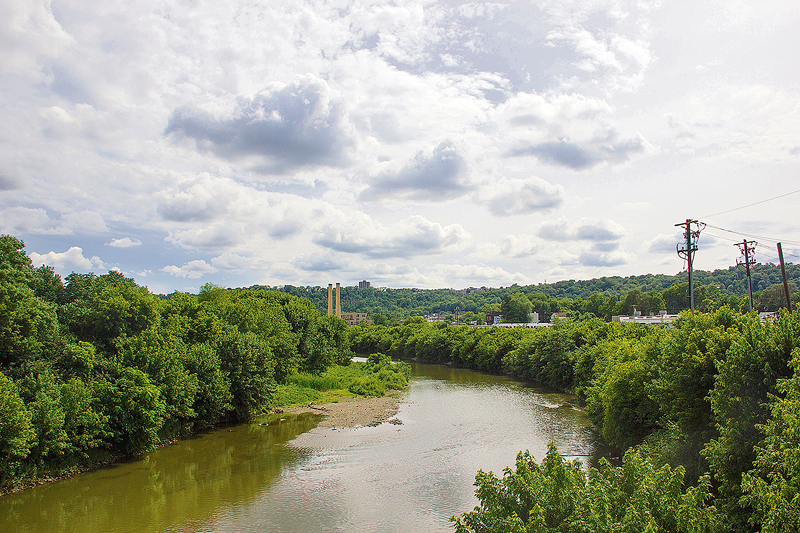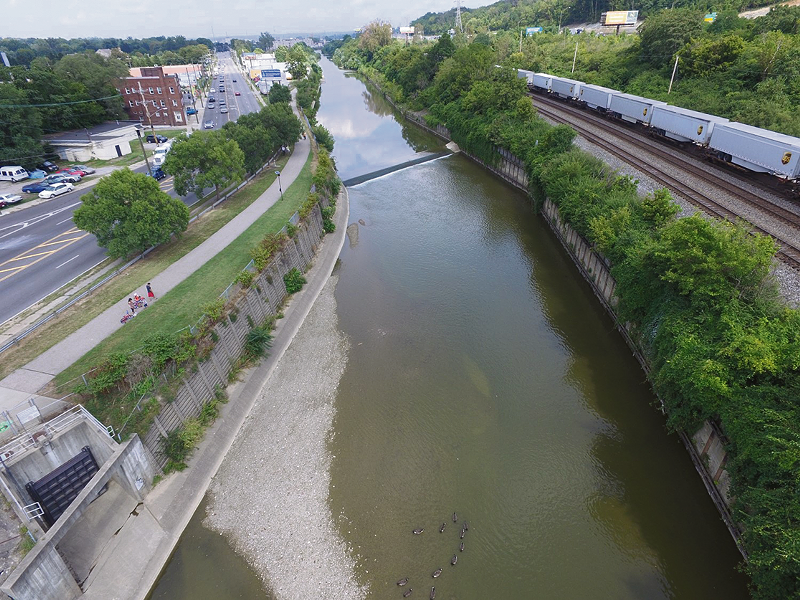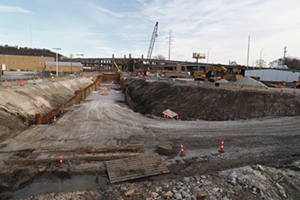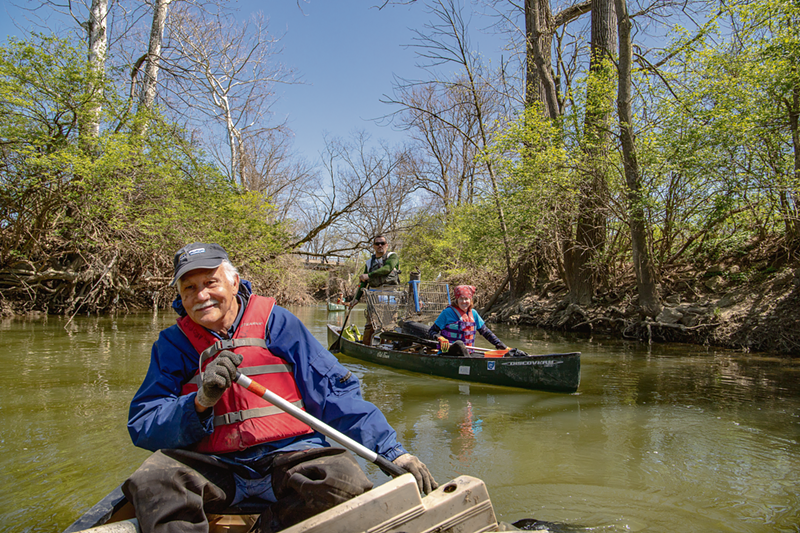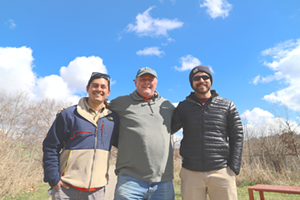In a bit of grass in Salway Park, across from the stately lawns of Cincinnati's Spring Grove Cemetery, there is a rectangular stone bearing a simple, mysterious inscription: “Mahketewah.”
The stone came from an aging, now-demolished warehouse building in the city's Queensgate industrial area, which is fitting in its own way. But the word itself, roughly meaning "it is black," is far older.
It’s the name native people, likely Shawnee, gave the waterway that now cuts through the heart of Cincinnati. Today, we call it the Mill Creek — if we talk about it at all.
Tanner Yess muses about the afterlife of the Mill Creek’s original moniker as we brave the March cold to tour a snow-dusted stretch of creek along Salway Park’s bike path. Not many words end up on both crumbling warehouses and Cincinnati country clubs, he says, but Maketewah (the most common spelling) did.
Like the creek itself, the name is largely forgotten by most people these days. But the path we’re on, like any number of other things around Salway Park, is part of a quarter-century effort to revive the Mill Creek — one that has the old stream starting to come to life again.
Yess is program coordinator for the newly minted Mill Creek Alliance, a merger of two groups that have long worked to better the stream. He is an enthusiastic, die-hard booster when it comes to the urban river’s past and future.
“There is a lot that Cincinnati owes to the Mill Creek,” he says as we survey its concrete retaining walls and muddy banks. “Basically, it’s the reason we’re here as a city. It was an Underground Railroad corridor. It was and still is the industrial backbone of the city, and it has suffered the consequences of that.”
The Mill Creek has gotten a bad rap for some good reasons. It was an open sewer for much of Cincinnati’s existence. Heavy industry, unencumbered by more recent regulations, used it as a dump site.
Except when it was flooding (or, in one instance, on fire), the stream often remained out of sight, out of mind during all that abuse.
But by the early 1990s, the Environmental Protection Agency was finding alarming levels of bacteria and pollution in the water, and in 1997, conservation group American Rivers named it the most endangered urban river in North America.
The attention deeply embarrassed the city — and helped solidify efforts around cleaning up the waterway.
Until recently, Yess worked for Groundwork Cincinnati - Mill Creek. Founded in 1994, Groundwork focused on engaging and empowering the communities along the stream to work on projects like bike paths, gardens and tree planting alongside the Mill Creek.
Another group, the Mill Creek Watershed Council of Communities, founded in 1995, has long been concerned with the technical aspects of fixing up shorelines, mitigating the effects of dams along the stream and other engineering projects in Cincinnati and municipalities to the north.
Earlier this year, the two groups converged to become the Mill Creek Alliance.
Dave Schmitt, the combined group’s executive director, is also on our chilly walk along the bike path, as is Alliance civil engineer Jim Moyer.
“That listing really got a lot of peoples’ attention,” Schmitt says of the dubious distinction bestowed on the Mill Creek by American Rivers two decades ago. “Frankly, it embarrassed a lot of people locally and statewide and brought a lot more resources.”
Those resources have started to pay off. Last November, American Rivers finally took the Mill Creek of its most endangered waterways list. Things are looking up — but there is still a lot of work to do to revive the Mill Creek. Trash is still an issue at times, for instance. Runoff from the increasing number of impervious surfaces in the region is causing erosion and flooding. And while some larger polluters have left the area or somewhat cleaned up their acts, there are still many smaller sources of pollution along the waterway.
“We’re about halfway there,” says Bruce Koehler, a former senior environmental planner at the Ohio, Kentucky and Indiana Regional Council of Governments who has been very active in efforts to revitalize the stream.
Koehler, sometimes known by “Commodore” for his role founding canoeing crew the Mill Creek Yacht Club 21 years ago, says his wife used to keep him from coming in the house when he got home from the stream due to the lingering smell of sewage. Now, 180 or so trips later, he’s allowed all the way to the laundry room thanks to the creek’s ongoing recovery.
For Koehler and other Mill Creek fans, the goal will never be to return the stream to some pristine state that existed before Cincinnati was built.
“The Mill Creek will never be completely natural,” he says. “It will never get back to its pre-civilization form. In the meantime, it’s gained a lot of heritage. I’d stack it up against any other stream for its history.”
The Past
Floating down the Mill Creek is a glide through Cincinnati’s origins. The 28-mile strand of water that runs from West Chester through the Queen City to the Ohio River juxtaposes the region’s vibrant green spaces with the sometimes-rusting mementos of its industrial past, but its impact on Cincinnati goes back about a million years or so before the first factory opened its doors.
Back then, what geologists call the Deep Stage Licking River — a giant precursor to the river that now flows through Northern Kentucky — roared through the heart of the land the Queen City now occupies.
That big river would literally clear the way for Cincinnati. The valley left behind when glaciers finally shuffled the Deep Stage Licking and the Ohio Rivers south about 250,000 years ago was — and remains — deep, flat and wide.
Native people lived there, likely for thousands of years. Beginning in the late 1700s, so did European settlers. They chased native people off and quickly began changing the land to their own ends — first for farming, and then to build industry as Cincinnati’s downtown basin filled up. The Miami and Erie Canal, built in 1827 just east of the creek, accelerated that growth.
Without the river’s big, flat valley, Cincinnati’s early expansion might have been much more arduous, perhaps stalled entirely until the advent of inclines to scale the city’s steep hills in the 1870s.
The Western Hills Viaduct — and the Cincinnati cultural divide it sometimes symbolizes — might not exist. Camp Washington Chili could be high atop a hillside today.
By 1880 more than 115 factories and other industrial sites existed in the valley, which in turn drew more workers to settle there. Camp Washington’s population shot from 3,000 people in 1880 to more than 11,500 by 1900. Cumminsville went from roughly 5,600 people to more than 14,000 in the same period.
With that influx of industry and humanity came pollution. In 1890, the Ohio Board of Health named the Mill Creek the “most foul waterway in the state.” An observer writing about the effects of the 1913 flood on poor inhabitants of the Mill Creek Valley for a book called The Survey said the creek was “the great open city sewer, foul and stifling during the warm months.”
The city began constructing a sewer system to convey waste and storm water to natural runoff locations — predominantly the Mill Creek — in 1828. Near the turn of the century, the city added so-called interceptor pipes, which trap sewage during dry conditions, but still allow for storm water and sewage to mix during heavy rain.
“The Mill Creek is the biggest piece of drainage infrastructure in its watershed,” Moyer says. “It’s 166 square miles — everyone’s storm water drains through it. Way back, it kind of seemed like a good idea that you would build your sewer system to just handle that everyday waste, and when it rains, it’s fine, you just run the extra out into the Mill Creek.”
That meant the stream got heavy doses of human waste along with the industrial runoff from the Mill Creek Valley’s myriad factories. The situation only got worse as the decades went on.
Sometime during the historic 1937 flood, overturned gasoline tanks caused the stream to burst into flames. Afterward, the Army Corps of Engineers began constricting the creek with concrete walls to try and prevent further flooding.
By the 1970s, Cincinnati’s economy was changing, and the communities around the Mill Creek Valley fell into decline. Those in the core of the city were the hardest hit, and continue today to have high rates of poverty, unemployment and low life expectancies.
“The Mill Creek corridor has gone through this long history,” Yess says. “There were settlers, then blue collar industry, then white flight, then housing developments and a lot of low-income, minority communities moved in and they’re bearing the brunt of the environmental issues.”
But residents there are also working to make the creek — and their communities — more vibrant.
The Communities
Growing up in South Cumminsville, Iyah Brown used to think environmental work was “hippie stuff.”
The community, hemmed in by the Mill Creek Valley, I-74, railyards and hulking former factories, can be a tough place. It is tight-knit and full of tenacious advocates, but also suffers a number of challenges.
Major employers like nearby Lunkenheimer Valve closed up shop beginning in the late 1960s, taking jobs with them. The environmental problems associated with industry, unfortunately, didn’t immediately go away when the factories did.
The neighborhood’s troubles were exacerbated by the construction of I-74 in the early 1970s. The highway effectively cut the neighborhood in half, creating what are now known as South Cumminsville and Northside.
Today, the median household income in South Cumminsville is $18,000 a year. Life expectancy here is five years less than the city’s average. The neighborhood is near brownfield sites and other environmental hazards.
But 21-year-old Brown is ambitious and curious, and at 18 she grabbed a seat on the neighborhood’s community council. She also started working in its community garden, where she met Yess.
Yess convinced her to join Green Team, a Groundwork youth program focused on clearing honeysuckle and planting trees around the Mill Creek. From there, she joined Green Corps, a similar program started in 2016 and focused on 18-24 year olds.
One of the big projects the Green Team and Green Corps have worked on is an effort to plant 10,000 native hardwood trees along the Mill Creek to commemorate its role in the Underground Railroad.
Those fleeing slavery could follow the Mill Creek north toward relative safety. Sometimes, that flight took a little imagination. Around 1850, the appropriately named Levi Coffin, a leader of the abolitionist movement, led a group of 28 travel-weary ex-slaves up the Mill Creek Valley after an arduous crossing of the Ohio River. To disguise themselves in not exactly fugitive-slave-friendly Cincinnati, they posed as a funeral procession, marching along the stream to a black cemetery in Cumminsville.
Since joining up with Groundwork, Brown hasn’t looked back. She’s become a passionate advocate for work around the Mill Creek and environmental issues in general.
“It affects our lives in ways we don’t realize, ways that most people don’t think about on a daily basis,” she says of the stream. “The Mill Creek was a critical part of our lives that people forgot about. It could still be a big part of lives. I’m a gardener and every natural resource affects what grows around here. It’s all really important and interconnected.”
Through Groundwork, Brown says she took her first trip on an airplane, flying to the Grand Tetons in Wyoming in the summer of 2016 for a series of workshops. Last year, she took another trip to Texas with the group for trail-building school.
She has also expanded her role in the community garden — she’s now a director there — and works on food access issues as an AmeriCorps VISTA (Volunteers in Service to America) for local nonprofit Working in Neighborhoods. Next, she’s mulling over which college to attend, likely for environmental work.
Brown says seeing the progress the Mill Creek is making is thrilling. She’s eager to talk about the 20 species of fish living in the stream now, or the fact she regularly sees deer, blue heron and turtles around the waterway.
“I love what I do, and I’m so happy to do it,” she says. “And we’re still at the beginning, so I’m going to get to see so much more happen.”
The Structures
While Groundwork has focused on building up people and communities, other work around reviving the Mill Creek is very much about infrastructure. On our walk around Salway Park, Mill Creek Alliance civil engineer Moyer points out one of two riffles — shallower, faster parts of the creek with rocky bottoms — the Alliance has been working on recently.
The riffles work by evening out water levels, helping fish swimming upstream from the Ohio River navigate a series of low-head dams put in place years ago by the Army Corps to limit flooding. The rock structures are part of larger restoration work here and at several other locations along the creek, including projects in Sharonville and Hartwell. The riffles also create spaces for wildlife to rest or live that aren’t otherwise available in the stream’s now-concrete channel.
“Historically, the Mill Creek wasn’t engineered to take into account the animals that live in it,” Moyer says. “This riffle doesn’t change the flood mitigation work that’s been done, but does create that habitat.”
Some of the infrastructure work is much bigger, and out of the hands of the Alliance. The Metropolitan Sewer District, following a 2006 federal court order to clean up sewage overflow, has cut waste drainage into the Mill Creek dramatically.
One of the most visible efforts on that front is the enormous Lick Run project in South Fairmount, which will daylight a creek buried in a pipe underground at the dawn of the city’s sewer system. That pipe carried another thing — raw sewage that overflowed from sewer pipes during heavy rains — into the creek with storm water. In addition to creating a park and stream on land once occupied largely by vacant, blighted buildings, the $190 million, two-and-a-half year effort — actually 12 linked projects — will keep carry 500 million gallons of storm water a year, keeping sewage overflow from ending up in the Mill Creek. Though the effort was downsized somewhat in 2015, it could still be transformational.
“The real guts of the project are underground,” Moyer says. “There’s a massive second pipe where all the things that get flushed through the toilet will be separate from all the storm water that’s coming down from the hill. The Mill Creek will still get the water coming out of that part of the city, but it won’t have things you would prefer not to have in your water.”
That’s a huge deal, Mill Creek watchers like Moyer say. But it doesn’t always take millions of dollars and a lot of concrete to get other things you’d prefer not to have in your water out of there — sometimes a handful of folks in canoes will do the trick.
Recovery
It’s 9 a.m. on a chilly Friday morning and a group is gathered behind a hardware store in Evendale to prepare for a voyage down the Mill Creek to pick up trash and debris. The motley crew, one of three teams deployed at various Mill Creek clean-up spots north of Cincinnati that day, is dressed in everything from waste-high waders to shorts and hiking boots.
The group, led by University of Cincinnati biology professor emeritus Mike Miller, Mill Creek Alliance’s Schmitt and City of Springdale’s Director of Public Works Jeff Agricola — all Mill Creek Yacht Club veterans — will spend the morning floating down a mile-long stretch of the stream.
After a brief pep talk from Agricola — who is no-nonsense about safety, but an affable joker about everything else —we’re ready to jump in. Soon we’re gliding down a sun-dappled green and brown corridor far removed from the suburban hustle and bustle above. The Mill Creek is perhaps the last such natural greenway by which wildlife can move around the region unencumbered by traffic, noise and other urban disruptions, Miller notes.
As we float, we pass another creek restoration site controlled by the Alliance. From the creek’s murky waters, we pluck out several tires, two shopping carts, the remains of what appears to be a plastic playhouse and a microwave, among other catches.
Miller is the true sage here. He’s been working on the Mill Creek since the 1970s and is a fount of knowledge about the waterway. He can bombard you with facts about combined sewage overflow — the mechanism by which sewage mixed with storm water ends up in the creek during flood events — then switch over to talk about how data on macroinvertebrates (that is, water-borne bugs you can see with the naked eye) show how far the Mill Creek has come.
In between fishing out plastic bags from the water, Miller points downstream toward a plant in Reading called Sanitary Sewage Overflow 700, the largest so-called SSO in the MSD system. That plant allows for the storage and cleaning of raw sewage before the water portion of that waste enters the Mill Creek.
“We have three humungous tanks that store several hundred gallons of raw sewage when it’s overflowing,” he says. “When those fill, it puts it through almost a centrifuge and the water circles really fast and the solids settle out in the middle. They remove the solids, add chlorine and put it back in the stream so the E. coli are dead. It’s a wee bit safer. We have very few overflows now.”
That water is cleaner than what comes out of sewage plants on the Little and Great Miami Rivers. It’s not one hundred percent up to federal standards, but it meets EPA requirements for those macroinvertebrates and for fish.
The return of that kind of wildlife is impressive, Miller says.
“The most amazing part is that the lower 7.2 miles of the Mill Creek meet guidelines for fish now,” he says. “That’s incredible because it was the dirtiest part. It smelled, had raw sewage. But work has brought that section back now.”
He’s not the only one to say the stream is bouncing back in some ways. A study conducted by the Midwest Biodiversity Institute released last summer shows that by many metrics, the creek is improving, though not completely clear.
“The 2016 Mill Creek results show that it continues to be a recovering system,” the 200-page study, which performed in-depth scientific tests on a number of criteria at 31 sites along the stream, summarizes. “Most sites that were rated as poor or very poor in 1992 and fair to marginally good in 2011were further improved to fair, good, and in a few instances exceptional quality in 2016.”
A few hours later, muck-covered trophies in tow, Miller and crew set ashore downstream. They didn’t get everything, but the cleanups happen fairly often. And trash is just one concern anyway.
The Work Ahead
One big challenge Mill Creek experts seem to agree is still looming ahead: slowing the flow of water running through the stream from parking lots and other impervious surfaces new development in the watershed is creating. When the land around the creek was covered in soil, it could absorb that water easily. Not so now, especially with changing weather patterns leading to increasing rainfall.
Decades ago, the Army Corps clad the Mill Creek in concrete to keep it from flooding. Now, ironically, concrete is speeding up its flow, causing erosion and a host of other problems.
There are plenty of other challenges to worry about as well.
“The Mill Creek is still suffering from a thousand cuts and we need to turn our sights to that,” the Yacht Club’s Koehler says. “Industries have pretty much cleaned up their act, at least the ones who have too much to lose for a pollution conviction. The sewer overflows are being cleaned up. But there are places where I see one-inch PVC pipe sticking out of the banks. That can’t be a permitted pipe. It could be laundry water discharge, or fly-by-night businesses, little garages, janitorial services. There are so many places in society that generate waste and want to get rid of it cheaply.”
Despite those challenges, Yess, Schmitt and others are optimistic about the future of the waterway.
As he walks the path in Salway Park, Yess points out an osage tree home to a rare family of black crown night herons. It’s one of just a few places in the state the bird is known to live. Nearby, there’s a sandbar he’s particularly excited about.
“That’s the river trying to be natural. It’s so cool — even in these confines, it’s saying, ‘I want to twist and turn and be a real river.’ It’s wild.”
As he explains the Laughing Brook, a recently completed man-made wetland that stores water from nearby parking lots and eventually releases it into the creek via a solar-powered pump, Yess can’t help but wax a little poetic.
“This is my favorite place in the city in the summer,” he says. “There will be all sorts of wetland flowers. Imagine, you’re down there doing your work, and you kind of get lost in the birds and the plants. Then, behind you, it’s the busiest corridor in the eastern United States, I-75. That collision between humans and nature is our future, and it’s right here.”


